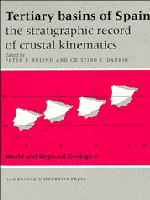Book contents
- Frontmatter
- Contents
- List of contributors
- Preface
- Dedication to Professor Oriol Riba IArderiu
- Memorial, Etienne Moissenet 1941–1994
- PART G GENERAL
- PART E EAST
- PART W WEST
- PART C CENTRE
- C1 Structure and Tertiary evolution of the Madrid basin
- C2 Neogene tectono-sedimentary review of the Madrid basin
- C3 Sedimentary evolution of lake systems through the Miocene of the Madrid Basin: paleoclimatic and paleohydrological constraints
- C4 Paleomorphologic features of an intra-Vallesian paleokarst, Tertiary Madrid Basin: significance of paleokarstic surfaces in continental basin analysis
- C5 Tectono-sedimentary analysis of the Loranca Basin (Upper Oligocene–Miocene, Central Spain): a ‘non-sequenced’ foreland basin
- C6 Paleoecology and paleoclimatology of micromammal faunas from Upper Oligocene – Lower Miocene sediments in the Loranca Basin, Province of Cuenca, Spain
- C7 Fluvial fans of the Loranca Basin, Late Oligocene – Early Miocene, central Spain
- C8 Saline deposits associated with fluvial fans, Late Oligocene – Early Miocene, Loranca Basin, Central Spain
- C9 Shallow carbonate lacustrine depositional controls during the Late Oligocene – Early Miocene in the Loranca Basin (Cuenca Province, central Spain)
- PART S SOUTH
- Index
C7 - Fluvial fans of the Loranca Basin, Late Oligocene – Early Miocene, central Spain
Published online by Cambridge University Press: 04 August 2010
- Frontmatter
- Contents
- List of contributors
- Preface
- Dedication to Professor Oriol Riba IArderiu
- Memorial, Etienne Moissenet 1941–1994
- PART G GENERAL
- PART E EAST
- PART W WEST
- PART C CENTRE
- C1 Structure and Tertiary evolution of the Madrid basin
- C2 Neogene tectono-sedimentary review of the Madrid basin
- C3 Sedimentary evolution of lake systems through the Miocene of the Madrid Basin: paleoclimatic and paleohydrological constraints
- C4 Paleomorphologic features of an intra-Vallesian paleokarst, Tertiary Madrid Basin: significance of paleokarstic surfaces in continental basin analysis
- C5 Tectono-sedimentary analysis of the Loranca Basin (Upper Oligocene–Miocene, Central Spain): a ‘non-sequenced’ foreland basin
- C6 Paleoecology and paleoclimatology of micromammal faunas from Upper Oligocene – Lower Miocene sediments in the Loranca Basin, Province of Cuenca, Spain
- C7 Fluvial fans of the Loranca Basin, Late Oligocene – Early Miocene, central Spain
- C8 Saline deposits associated with fluvial fans, Late Oligocene – Early Miocene, Loranca Basin, Central Spain
- C9 Shallow carbonate lacustrine depositional controls during the Late Oligocene – Early Miocene in the Loranca Basin (Cuenca Province, central Spain)
- PART S SOUTH
- Index
Summary
Abstract
During Late Oligocene to Early Miocene times the Loranca Basin was filled by a thick sequence of continental deposits comprising three large depositional systems, Tórtola, Villalba de la Sierra and Valdeganga. Stratigraphic and sedimentological methods enable palaeoenvironmental reconstructions and the tectonic deformation history to be related to long-term palaeogeographic changes. Each depositional system consists of a fluvial fan and associated floodbasin and distal deposits, which were dominated by saline lakes. Syn-sedimentary alluvial fans fringed the basin margins, reflecting their differential tectonic movements. Topographic changes induced by fold generation controlled facies distribution evolution. The large fluvial fans contained many channel systems, and all the channel types identified in recent rivers are found. In proximal fan areas, braided channels predominated, but meander loops, and braided and other low-sinuosity channel types are found extensively across the fan surfaces. The stratigraphic successions are characterized by a high content of finer-grained deposits. Their sandstone composition reveals source areas composed of sedimentary rocks for all the depositional systems. Differences in composition of the main sediment supplies reflect diversity in the relative proportion of the different sedimentary rocks in the catchment areas. In contrast, variation in composition down the fans reflects local tributary mixing situations, both between fans or between more local alluvial systems.
Introduction
The Loranca Basin is located in the central part of Spain, within the Iberian Range (Fig. 1). This basin was formed during Eocene to Late Oligocene times and contains continental deposits locally folded along with the underlying Mesozoic rocks.
- Type
- Chapter
- Information
- Tertiary Basins of SpainThe Stratigraphic Record of Crustal Kinematics, pp. 300 - 307Publisher: Cambridge University PressPrint publication year: 1996
- 5
- Cited by

